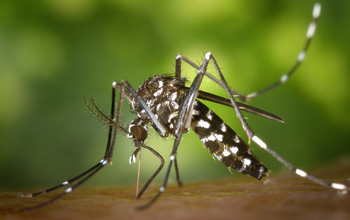News Release 16-055
National Science Foundation awards $1.7 million in rapid response grants to study Zika virus
Funding to address ecological transmission dynamics of the virus

One Zika-carrying mosquito, Aedes albopictus, the Asian tiger mosquito, ranges northward.
May 11, 2016
This material is available primarily for archival purposes. Telephone numbers or other contact information may be out of date; please see current contact information at media contacts.
To find new ways of halting the spread of Zika -- fast becoming a major public health threat -- the National Science Foundation (NSF) Division of Environmental Biology's Ecology and Evolution of Infectious Diseases (EEID) Program has funded nine rapid response, or RAPID, grants totaling $1.7 million.
"Each new infectious disease presents an ongoing challenge to public health," says James Olds, NSF assistant director for Biological Sciences. "Recognizing the need for urgency, NSF is making these RAPID awards to understand the rate of spread, number of people infected, and likely persistence of Zika as a public health threat, and to help us prepare for the next outbreak."
An emerging threat
Discovered in Uganda in 1947, Zika has been documented since the 1950s along the equatorial belt from Africa to Asia. In 2014, the virus spread eastward to French Polynesia, and in 2015 to Mexico, Central America, the Caribbean (including Puerto Rico) and South America, where the outbreak continues.
Zika is transmitted to humans through the bite of an infected Aedes aegypti mosquito. Because this mosquito is found throughout the world, it’s likely that outbreaks will spread to new countries, scientists say.
Now, researchers have detected the Zika virus in a second mosquito species in the Western Hemisphere, Aedes albopictus, known as the "Asian tiger mosquito," increasing the number of people at risk for the disease.
Unlike Aedes aegypti, which in the U.S. is found mostly in the Southeast and along the Gulf Coast, Aedes albopictus has a range as far north as New England and the lower Great Lakes states. During the summer, when mosquitoes are most abundant in the U.S., Aedes albopictus is often more common than Aedes aegypti.
Zika symptoms are fever, rash, joint pain, and conjunctivitis ("pink eye"). The illness usually lasts from several days to a week.
However, a woman who is infected with Zika during pregnancy has an increased risk of having a baby with microcephaly. It may also be responsible for neurologic conditions in adults such as Guillain-Barre syndrome, which results in extreme muscle weakness.
Rapid response to Zika
NSF's EEID Program funds the development and testing of predictive models, and discovery of the principles governing the transmission dynamics of infectious diseases such as Zika.
NSF Zika rapid response projects include:
- Environmental drivers of Zika transmission and control.
- Zika vector-climate dynamics in a high-burden region in Ecuador.
- Overcoming uncertainty to enable estimation and forecasting of Zika virus transmission.
- Data-driven mathematical modeling of the shared epidemiology of Zika and similar viruses across the globe.
- And potential enhancement of Zika virus transmission by microfilarial nematodes (blood pathogens).
One example of RAPID-supported research, led by Anna Stewart at SUNY Upstate Medical University, is a study of the socio-ecology and climate responses of Zika virus transmission by catching Aedes aegypti mosquitoes in southern coastal Ecuador. Ecuador is one of 26 countries in the Americas that has reported active Zika virus transmission, according to the U.S. Centers for Disease Control and Prevention.
The towns in Ecuador where the scientists are working -- Machala, Huaquillas, and Portovuelo/Zaruma -- vary in climate, elevation and socioeconomic conditions, and in their amount of mosquito-borne disease. In recent studies, Machala had the greatest abundance of Aedes aegypti larvae of all sites surveyed in 10 countries in Latin America and Asia, indicating a high risk for virus transmission.
NSF Zika RAPID Grants
David Abramson, New York University, RAPID: An Evolving Risk Communication Challenge: The Risk Salience of Zika Virus Infection in an Environment of Shifting Scientific, Social, and Policy Uncertainty and Discourse [co-funded with NSF's Directorate for Social, Behavioral & Economic Sciences]
-NSF-
-
The Aedes aegypti mosquito carried the Zika virus from Africa to the Americas.
Credit and Larger Version -
Countries and territories with active Zika virus transmission, as of April 18, 2016.
Credit and Larger Version -
Transmission electron micrograph (TEM) of the Zika virus.
Credit and Larger Version -
Use of insect repellant is advisable in several regions, scientists say.
Credit and Larger Version -
Mosquito traps are now common in places like Mexico City.
Credit and Larger Version
Media Contacts
Cheryl Dybas, NSF, (703) 292-7734, email: cdybas@nsf.gov
Related Websites
Seeking Zika: Where and when will Zika-carrying mosquitoes strike next?: http://www.nsf.gov/news/news_summ.jsp?cntn_id=137712
Potential Zika virus risk estimated for 50 U.S. cities: https://www.nsf.gov/news/news_summ.jsp?cntn_id=137907
National Science Foundation issues call for Zika virus proposals: http://www.nsf.gov/news/news_summ.jsp?cntn_id=137621
NSF Special Report: Ecology and Evolution of Infectious Diseases: http://www.nsf.gov/news/special_reports/ecoinf/
To slow the spread of infectious diseases, NSF, NIH, USDA support new research: https://www.nsf.gov/news/news_summ.jsp?cntn_id=136044
The U.S. National Science Foundation propels the nation forward by advancing fundamental research in all fields of science and engineering. NSF supports research and people by providing facilities, instruments and funding to support their ingenuity and sustain the U.S. as a global leader in research and innovation. With a fiscal year 2023 budget of $9.5 billion, NSF funds reach all 50 states through grants to nearly 2,000 colleges, universities and institutions. Each year, NSF receives more than 40,000 competitive proposals and makes about 11,000 new awards. Those awards include support for cooperative research with industry, Arctic and Antarctic research and operations, and U.S. participation in international scientific efforts.
Connect with us online
NSF website: nsf.gov
NSF News: nsf.gov/news
For News Media: nsf.gov/news/newsroom
Statistics: nsf.gov/statistics/
Awards database: nsf.gov/awardsearch/
Follow us on social
Twitter: twitter.com/NSF
Facebook: facebook.com/US.NSF
Instagram: instagram.com/nsfgov







